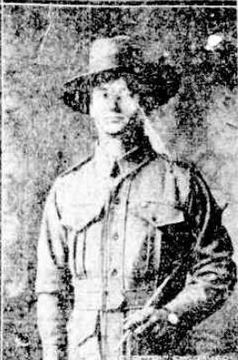KETTERER, Victor Ambrose
| Service Number: | 1490 |
|---|---|
| Enlisted: | 12 November 1914 |
| Last Rank: | Lieutenant |
| Last Unit: | 16th Infantry Battalion (WW1) |
| Born: | Nerring, Victoria, Australia, 1883 |
| Home Town: | Kalgoorlie, Kalgoorlie/Boulder, Western Australia |
| Schooling: | Not yet discovered |
| Occupation: | Engineer |
| Died: | 1936, cause of death not yet discovered, place of death not yet discovered |
| Cemetery: | Not yet discovered |
| Memorials: |
World War 1 Service
| 12 Nov 1914: | Enlisted AIF WW1, Private, 1490, 16th Infantry Battalion (WW1) | |
|---|---|---|
| 22 Feb 1915: | Involvement Private, 1490, 16th Infantry Battalion (WW1), --- :embarkation_roll: roll_number: '12' embarkation_place: Fremantle embarkation_ship: HMAT Itonus embarkation_ship_number: A50 public_note: '' | |
| 22 Feb 1915: | Embarked Private, 1490, 16th Infantry Battalion (WW1), HMAT Itonus, Fremantle | |
| 31 Oct 1917: | Promoted AIF WW1, Lieutenant, 16th Infantry Battalion (WW1) |
Help us honour Victor Ambrose Ketterer's service by contributing information, stories, and images so that they can be preserved for future generations.
Add my storyBiography contributed by Stephen Brooks
Victor Ambrose Ketterer was a unique soldier in that he landed on Gallipoli on Anzac Day 1915 and was still serving on the last day that his Battalion fought on the Western Front in 1918. He rose from Private soldier in 1914 to Lieutenant in 1918 and was decorated with the Military Cross and was twice mentioned-in-despatches. In the post war period, he and his wife devoted themselves to the welfare of ex-servicemen and war widows.
Vic Ketterer was born in Victoria in 1883; he trained as an engineer and settled in Kalgoorlie around 1908. With the outbreak of war in 1914 he made three unsuccessful attempts to join the AIF but was rejected because of his diminutive stature. On the fourth attempt he was enrolled and assigned to the Second Reinforcements of the 16th Battalion with the regimental number of 1490. He departed Australia on 22 Feb 1915 and landed in Egypt for further training.
Private Ketterer went ashore on 25 April 1915 at Anzac Cove. The reinforcements were actually landed ahead of the main body of the Battalion and worked as beach labourers (under fire). During the campaign on the Gallipoli peninsula Victor Ketterer was promoted to Corporal and later to Sergeant and was mentioned-in-despatches. His recommendation for the MID states “conspicuous good work in frequently conducting munition parties under heavy fire. For coolness and the excellent manner he has carried out his duties.”
In 1916 the Battalion was moved to the Western Front through the Port of Marseilles. Victor Ketterer was promoted to Warrant Officer rank in August 1916 and mentioned-in-despatches for a second time. The recommendation states “he has always displayed the greatest devotion to duty and is always to be implicitly relied on. During the recent operations to the north of Pozieres his work in keeping his Company supplied with ammunition and supplies was particularly praiseworthy. He never allowed diverse weather conditions or artillery barrages of the severest character to interfere with his work but always personally conducted the carrying parties and got his supplies through. He is recommended for distinction.”
On 8 February 1917 he was commissioned in the field as a Second Lieutenant and on 31 October 1917 promoted to Lieutenant. For gallantry on 18 September 1918 Lt Ketterer was awarded the Military Cross for capturing an enemy machine gun post in the advance to Le Verguier, France. This was the last day that the 16th Battalion fought in the Great War.
'For gallantry and initiative as intelligence officer, on 18th September 1918, when an attack was being made on Le Vergieur, north west of St. Quentin. He personally placed the jumping off tapes, and subsequently supervised the placing of the infantry on their jumping off positions. During the attack he kept in touch with progress of the attack, and kept battalion headquarters informed thereof. Whilst doing so he located an enemy machine gun position which had been missed by our troops, and which was firing into the back of the leading companies. He immediately attacked the position, and with the aid of his runner succeeded in capturing the gun, killing two and taking three of the crew prisoners. Throughout he showed the greatest initiative, and maintained an exceedingly high standard of gallantry.'
Lt Ketterer was next appointed, by General Monash, to serve with the 27th Infantry Division of the United States Army as they took over the line from the British Forces. He returned to the AIF before the Armistice on 11 November 1918. After the War he returned to Australia and was discharged from the AIF on 28 March 1919.
In the post war period Victor Ketterer worked for the Repatriation Commission (now Veterans Affairs) servicing the needs of ex-servicemen. He was exceedingly active in the RSL and was an office bearer of the Nedlands sub-branch for many years. His wife served on the RSL Auxiliary and was president of the War Widows Guild for many years.
Victor Ketterer died at his home in 1936 from Pulmonary Tuberculosis, (war wounds).











